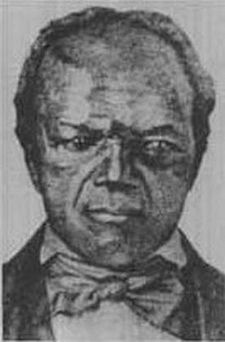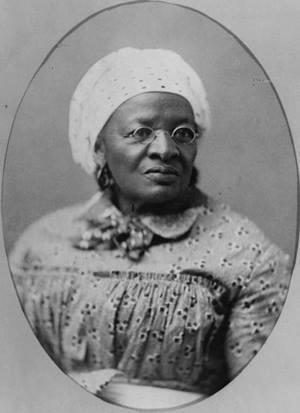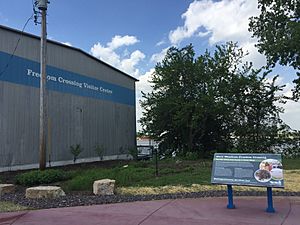John Berry Meachum facts for kids
Quick facts for kids John Berry Meachum |
|
 |
|
| Born | May 3, 1789 in Goochland County, Virginia |
|---|---|
| Died | February 26, 1854 (aged 64) in St. Louis, Missouri |
| Ordained | 1825 |
| Writings | An Address to All of the Colored Citizens of the United States |
| Congregations served | First African Baptist Church, now named First Baptist Church City of St. Louis |
| Spouse | Mary Meachum |
John Berry Meachum (1789–1854) was an amazing American pastor, businessman, and teacher. He founded the First African Baptist Church in St. Louis. This was the oldest Black church west of the Mississippi River.
At a time when it was against the law to teach Black people to read, Meachum ran a secret school. He taught classes in the church's basement. When Missouri laws made it even harder to teach Black people, Meachum found a clever way around it. He created the Floating Freedom School on a steamboat on the Mississippi River. This way, his school was outside of Missouri's laws.
As a young man, he helped 75 enslaved people escape from Kentucky to freedom in Indiana. Once he settled in Missouri, he and his wife, Mary Meachum, became conductors on the Underground Railroad. They also bought enslaved people and let them live in their home. These individuals worked for the Meachums and saved their earnings. Once they saved enough to repay their purchase price, the Meachums freed them. They also taught them skills to live on their own. John and Mary helped many runaway enslaved people cross the Mississippi River into Illinois. The Mary Meachum Freedom Crossing in St. Louis is named after Mary. It is a special site that honors her work on the Underground Railroad.
In 1846, Meachum spoke at a big meeting called the National Negro Convention. He also wrote a pamphlet called An Address to All of the Colored Citizens of the United States. In it, he talked about how important education and self-respect were for Black people.
Contents
The Meachums' Early Life
John Berry Meachum was born on May 3, 1789, in Goochland County, Virginia. His parents, Thomas Granger and Patsy, were enslaved. John was also born into slavery. His owner was Paul Meachum. The family moved to North Carolina, then to Hardin County, Kentucky.
John's owner allowed him to work and earn money. John worked in a saltpeter cave and as a carpenter. When he was 21, he saved enough money to buy his own freedom. After becoming free, John walked 700 miles back to Virginia. There, he bought his father's freedom for 100 Virginia pounds. John was baptized in Virginia in 1811. Later, John and his father saved more money. They walked back to Kentucky and bought the freedom of John's mother and siblings. His family then settled in Harrison County, Indiana.
John stayed in Kentucky and married an enslaved woman named Mary. John's former owner, Paul Meachum, was very old. He offered to free his 75 enslaved people if John would lead them to freedom. John agreed and led the group across the Ohio River to Indiana. Most of these newly freed people settled near Corydon.
When John returned to Kentucky, he learned that Mary's owners had taken her and their children to St. Louis, Missouri. In 1815, John moved to St. Louis with only three dollars. He worked as a carpenter, cabinet maker, and cooper. He saved all his earnings to buy the freedom of Mary and their children. He was very good at his work and made a good living.
John's Work
Minister
In St. Louis, John Meachum met white Baptist missionaries. They had started a Sunday school for Black people in 1817. John began preaching and helping them in 1821. In 1825, he became an ordained minister.
Meachum then built a separate building for the First African Baptist Church and school. It opened in 1827 and was the first Black church west of the Mississippi River. By then, 220 people attended, including 200 enslaved people. Enslaved people needed their owners' permission to attend church. The church grew to 500 members by the 1840s. The First African Baptist Church, now called First Baptist Church City of St. Louis, moved to a new location in 1848.
Educator
Starting in 1822, Meachum taught religious and regular classes. He taught both free and enslaved African Americans. This was the first known school for Black people in Missouri. It was called the Candle Tallow School. Students who could pay were charged one dollar for tuition. Classes were held secretly in the church's basement.
In 1825, St. Louis passed a law that banned the education of free Black people. Breaking this law could mean being whipped, fined, or jailed. In 1847, the police closed Meachum's school. They arrested Meachum and a white teacher. The state of Missouri banned all education for Black people. It also stopped them from having their own religious services without a white officer present.
Meachum found a way to continue teaching. He moved his classes to a steamboat in the middle of the Mississippi River. The river was under federal law, not Missouri's state laws. He filled the boat with a library, desks, and chairs. He called it the "Floating Freedom School". This allowed Meachum to keep teaching Black people, both free and enslaved.
One of Meachum's students was James Milton Turner. He was at the school when Meachum was arrested. Later, Turner became a diplomat to Liberia. After the Civil War, he founded the Lincoln Institute. This was the first school for higher education for Black students in Missouri.
Entrepreneur
Meachum worked as a carpenter and a cooper (someone who makes barrels). He used his money to buy enslaved people. These individuals then studied and worked for him. They saved their earnings. Once they paid him back, Meachum freed them. By 1835, Meachum was quite wealthy. He even built a riverboat with a library. He used it to promote good habits.
Life with Mary
John Meachum married Mary, who was born around 1805 in Kentucky. They had two children, John and William. In 1840, their home had 10 free Black people and six enslaved people living with them. By 1850, eight Black people lived with them, including two boatmen.
Underground Railroad
John and Mary Meachum helped many enslaved people escape to freedom. They used boats to transport people across the Mississippi River to Illinois, which was a free state. The Meachums used money from their successful businesses to buy and free enslaved individuals. John also provided job training. He owned two riverboats and a barrel-making factory. Escaped enslaved people worked there and saved their earnings.
Between 1826 and 1836, the Meachums bought and freed about 20 enslaved people. Almost everyone they freed paid them back. This money then helped them free even more people.
By 1846, Meachum had purchased the freedom of 22 people. He taught them job skills and life skills to help them be independent. That year, he spoke at the National Negro Convention in Philadelphia. He also published his pamphlet, An Address to All of the Colored Citizens of the United States. In it, he stressed the importance of working together and having self-respect. He believed Black people needed practical education to support themselves after gaining freedom. He used Bible verses to support his ideas, like Proverbs 22:6: "Train up a child the way he should go and when he is old he will not depart from it." He also wrote that schools should teach children to be religious and hardworking.
Mary's Crossing (1855)
After John's death, Mary continued her work with the Underground Railroad. On May 21, 1855, she and a free Black man named Isaac traveled by boat. They were helping nine enslaved people cross the Mississippi River to Illinois. Once they reached the shore, they were arrested. This was for breaking the Fugitive Slave Act of 1850. On May 24, Mary was accused of stealing enslaved people. The charges against Isaac were dropped. A newspaper reported that Mary was tried by a jury and found not guilty of at least one charge. The other charges were then dropped.
The Colored Ladies Soldiers' Aid Society
Mary Meachum was the president of the Colored Ladies Soldiers' Aid Society in St. Louis. At that time, Black people were not allowed to ride streetcars. The women of the society talked with the streetcar company. They arranged to ride the streetcar one day a week, on Saturdays. This allowed the members to visit wounded soldiers at a special hospital section in St. Louis.
Death
John Berry Meachum died while preaching on February 26, 1854. He is buried in Bellefontaine Cemetery in St. Louis. Mary Meachum died in St. Louis on August 8, 1869. She is also remembered with her husband at Bellefontaine Cemetery.
Legacy
- The Mary Meachum Freedom Crossing is part of the National Park Service's National Underground Railroad Network to Freedom. It was dedicated on November 1, 2001. Each year, it hosts the Mary Meachum Freedom Crossing Celebration. This event includes re-enactments of Mary Meachum's river crossing and arrest. The site is just north of the Merchants Bridge in St. Louis.
- The John Berry Meachum Scholarship was created at Saint Louis University. It honors Meachum's work as a minister, church founder, educator, and businessman. This scholarship helps medical students at the university.
- The Meachum School of Haymont is a religious school named after John Berry and Mary Meachum.



